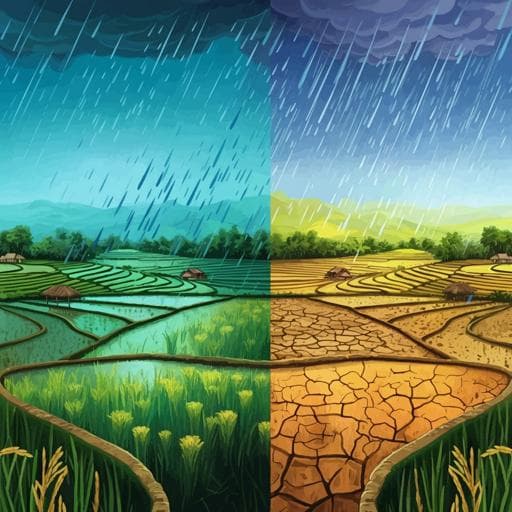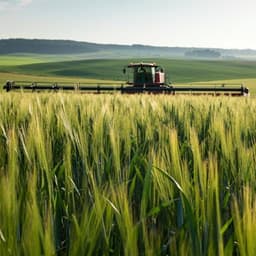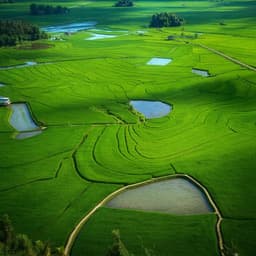
Agriculture
Optimal rainfall threshold for monsoon rice production in India varies across space and time
A. Maiti, M. K. Hasan, et al.
Discover how climate change affects rice yield in India in a groundbreaking study by a team of international experts. With analysis spanning 27 years, the research reveals the critical role of monsoon rainfall—showing yields can decline by over 33% with excessive rain. Join the conversation by the authors as they uncover these vital insights!
~3 min • Beginner • English
Introduction
Rice is the primary calorie source for over half of the global population, and India is the second-largest producer, contributing nearly 20% of global rice output. Kharif (monsoon) rice accounts for about 85% of India’s total rice production, making its performance during the June–November monsoon season crucial for domestic food security and global markets. Climate variability, particularly rainfall amount and distribution, is a dominant driver of crop yield variability, and extreme events are increasing with global warming. In India, monsoon-dependent crops, including Kharif rice, are especially sensitive to rainfall variability. Prior work indicates nonlinear yield responses to rainfall, with potential declines when rainfall deviates from an optimal level, and excessive monsoon rainfall has been associated with yield losses, especially in high-rainfall regions of the northeast. The Indian monsoon is tightly linked to ENSO, which modulates rainfall and can affect national rice production. However, the optimal rainfall threshold (ORT) for Kharif rice, and the relative impacts of both rainfall deficits and excesses across space and time, remain insufficiently quantified. This study analyzes district-level data (1990–2017) across India to quantify the rainfall–yield relationship, identify national and state-level ORTs, evaluate spatiotemporal heterogeneity, and relate yield anomalies to ENSO-driven rainfall variability.
Literature Review
Existing studies show climate variation explains roughly one-third of global crop yield variability, with rainfall and temperature as primary controls. In India, monsoon crops show higher sensitivity to rainfall variability than winter crops, and rainfall variability can cause sizable fluctuations in rice output. Studies have reported adverse effects of excessive monsoon rainfall on crop yields, particularly in northeastern India. Literature also documents a nonlinear rainfall–rice yield relationship, implying diminishing returns and yield declines beyond an optimal rainfall level. Despite this, most prior work emphasized losses under excessive rainfall and provided limited insight into thresholds capturing both deficit and excess effects for monsoon rice. Some related research examined precipitation thresholds for other crops (e.g., wheat and maize) in different regions, but a comprehensive ORT assessment for India’s Kharif rice, including spatial and temporal variability and comparison with drought impacts, has been lacking. ENSO’s influence on Indian monsoon rainfall and related agricultural outcomes is well recognized, motivating integration of ENSO metrics into yield–rainfall analyses.
Methodology
Data were compiled for Kharif (monsoon) rice at district level across India for 1990–2017 from the ICRISAT database, including harvested area, production, and yield. Gridded daily rainfall (0.25°) and air temperature (1°) from IMD for June–November were aggregated to districts via area-weighted means, using 1993 district boundaries. June–July rainfall was included given its agronomic role in field preparation prior to transplanting. ENSO conditions were represented by the Oceanic Niño Index (ONI), using three-month (May–July) means. The primary analytical approach used multivariate log-linear mixed-effects models to estimate yield as a function of time and climate: a counterfactual baseline with time terms only, and a full model including rainfall (linear and quadratic) and, in robustness checks, temperature (linear and quadratic). Location (district/state) effects were treated as random intercepts to account for unobserved, time-invariant heterogeneity (e.g., soil). Fixed effects included year and rainfall (and their squared terms) to capture potential nonlinear climate–yield responses. Relative yield change (RYC) was computed as percentage difference between the full model’s predicted yield (with rainfall trends) and the counterfactual predicted yield (without long-run rainfall trends). Net production impacts were obtained by multiplying planted area with model-derived yields. To identify the optimum rainfall threshold (ORT), segmented (piecewise) regression on RYC versus growing-season rainfall was applied to detect a breakpoint (ψ) at which the slope of the rainfall–RYC relationship changes, representing the ORT. Slopes on both sides of the breakpoint quantified sensitivity to rainfall deficits (left slope) and excess (right slope). A sensitivity metric expressed the relative change in response beyond ORT compared to below ORT: Sensitivity = 100% × (Slope_right − Slope_left)/Slope_left. Temporal evolution of ORT and related metrics was assessed using 3-year intervals across 1990–2017. Relationships among ORT, slope magnitudes, percentage of samples above ORT, and yield outcomes were evaluated via linear regression. ENSO impacts were examined by correlating ONI with spatially averaged growing-season rainfall and with estimated annual RYC. Model performance metrics (from the mixed-effects model with rainfall and temperature) included conditional R² = 0.786, marginal R² = 0.066, RMSE = 0.281, Sigma = 0.287, with 10,251 observations; rainfall had a significant positive linear and significant negative quadratic effect on yield, while temperature effects were weaker/non-significant in the model specification reported.
Key Findings
- Production and yield trends (1990–2017): National Kharif rice production rose from 71.37 MT (1990) to 113.28 MT (2017), a 58.7% increase (52.5% on a unit-area basis). Yield increased from 1669.73 to 2418.16 kg ha−1. Highest annual yield growth rates (>34 kg ha−1 yr−1) occurred in Andhra Pradesh, Bihar, Jharkhand, Rajasthan, Tamil Nadu, Telangana, and West Bengal; lowest in Uttarakhand (5.25), Maharashtra (9.92), Himachal Pradesh (13.48), and Haryana (13.72).
- Spatial rainfall and correlations: 28-year average growing-season rainfall was highest along the Western Ghats and parts of eastern India, and lowest in western non-coastal, northern, and southern regions. Of 384 districts, 63.3% showed positive rainfall–yield correlations; 36.7% negative. Strong positive correlations (r ≥ 0.4, p < 0.05) occurred in Chhattisgarh, Odisha, Madhya Pradesh, Telangana, and western Karnataka; negative correlations of similar magnitude in several other states (e.g., Andhra Pradesh, Assam, Haryana, Himachal Pradesh, Kerala, northern Uttar Pradesh, Punjab, Tamil Nadu, West Bengal, west Maharashtra).
- Model effects: Rainfall had a significant positive linear effect and significant negative quadratic effect on yield (p ≤ 0.001); overall conditional R² = 0.786, marginal R² = 0.066; 10,251 observations.
- Relative yield change (RYC) by year: Notable losses included 2003 (−5.22%), 2009 (−3.12%), and 2014 (−3.24%). Gains were largest in 2008 (3.74%), 2012 (3.44%), and 2014 (4.85%). Western regions and eastern Assam tended to show net production losses attributable to rainfall compared with eastern and southern India.
- National ORT: The nationwide optimum rainfall threshold is 1621 ± 34 mm (CI 1587–1655 mm), based on the relationship between growing-season rainfall and RYC (R² = 0.34, p < 0.001). Extreme wet conditions were associated with −33.74% yield change, while extreme dry conditions with −19%. Beyond the ORT, yield declines by 6.41 kg ha−1 per additional 100 mm; below the ORT, yield declines by 17 kg ha−1 per 100 mm decrease in rainfall.
- ORT vs. rainfall: ORT increases with mean growing-season rainfall across states (r = 0.87, p < 0.001), indicating adaptation to higher moisture regimes in wetter states.
- State-level thresholds: Among 20 states contributing >95% of production, 14 had identifiable ORTs. ORTs ranged from 544 ± 87 mm (Haryana) to 2775 ± 106 mm (Kerala). Above ORT, yield losses per +100 mm were: Kerala (−17.5 kg ha−1), Maharashtra (−38.1), Karnataka (−2.4), Uttarakhand (−5.5), West Bengal (−9.9). Below ORT, some states showed >50 kg ha−1 loss per −100 mm; many others 20–50 kg ha−1 (e.g., Andhra Pradesh). Specific ORTs reported include Assam (1485 mm), Bihar (1205 mm), Uttarakhand (1197 mm), and West Bengal (1816 mm, with ~23% of observations above ORT and up to 20% yield decline).
- Spatial coverage relative to ORT: Nationally, 89.25% of observations fell below ORT and 10.75% above. States without identifiable ORTs (showing U-shaped rather than inverted-U relationships) included Andhra Pradesh, Himachal Pradesh, Punjab, and Rajasthan, indicating rainfall during the season remains below the level that would induce surplus-related declines.
- Sensitivity: The overall sensitivity of RYC to rainfall between the two sides of ORT was −145.45%, indicating impacts switch from positive to negative beyond ORT with >45% greater magnitude. Stronger wet-side sensitivities were found in Karnataka (−105%), Kerala (−290%), Maharashtra (−159%), and West Bengal (−145%).
- Temporal evolution (3-year windows): A 100 mm increase in ORT was associated with +102 kg ha−1 yield (RYC ≈ 0.3%), R² = 0.75 (p < 0.01). As ORT rose, the fraction of observations above ORT (i.e., at risk of wet-side losses) decreased (R² = 0.56, p < 0.05). Left and right slope magnitudes were inversely correlated with ORT, with yield-loss intensity on the wet side increasing as ORT increased.
- ENSO linkages: ENSO phases aligned with rainfall anomalies (e.g., El Niño years 1991, 1997, 2002, 2009, 2015 with drier conditions; La Niña years 1998, 1999, 2007, 2010 with wetter conditions). Mean growing-season rainfall correlated with ONI (reported r = 0.49, p < 0.01), and RYC correlated negatively with ONI (r = −0.61, p < 0.001), consistent with reduced yields under El Niño and improved yields under La Niña.
Discussion
Findings confirm a nonlinear, inverted-U relationship between growing-season rainfall and Kharif rice yields across much of India, with an identifiable optimum rainfall threshold. Below ORT, additional rainfall benefits yields where water demand is unmet; beyond ORT, excess moisture is detrimental, likely due to flooding, waterlogging, nutrient leaching (notably nitrogen), and soil structural damage. The national ORT (1621 ± 34 mm) and state-specific ORTs reveal substantial spatial heterogeneity tied to regional climatology and agronomic adaptation. The strong dependence of ORT on mean rainfall suggests local cultivars and management practices confer some resilience to higher moisture regimes. Temporal analyses indicate that periods with higher ORTs are associated with modest yield gains and fewer instances exceeding ORT, but wet-side yield loss intensity can grow as ORT rises, underscoring complex adaptation dynamics. The robust association between ENSO, monsoon rainfall anomalies, and yield implies seasonal climate signals are informative for anticipating yield risks: El Niño tends to elevate drought risk and yield losses, while La Niña often enhances rainfall and yields, though localized excess rainfall can still be harmful. Overall, defining ORTs provides a practical diagnostic for aligning water supply with crop water demand to guide risk management and optimize yields under climate variability.
Conclusion
This study establishes national and state-level optimum rainfall thresholds for India’s Kharif rice using district-scale observations and mixed-effects plus segmented regression modeling for 1990–2017. The nationwide ORT is 1621 ± 34 mm, with yields declining both below and above this threshold, and larger potential losses under extreme wet conditions than under drought. ORTs vary widely across states (≈544–2775 mm), reflecting regional hydroclimate and adaptation. Approximately 89% of observations were below ORT nationally, indicating that in most regions additional water could benefit yields up to the threshold, whereas about 11% faced risks from excessive rainfall. ENSO-driven rainfall anomalies strongly relate to yield variability, reinforcing the value of climate information for agricultural planning. These findings can inform region-specific strategies such as adjusting planting dates, employing stress-tolerant varieties, managing irrigation and fertilizer inputs, and adopting soil and water conservation measures to mitigate both drought and flood risks. Future work could incorporate additional drivers (e.g., technological changes, market forces, and policy interventions) and explore cultivar-specific and phenology-stage-specific thresholds, as well as interactions with irrigation expansion and intraseasonal rainfall distribution.
Limitations
The modeling focuses on rainfall (and robustness checks with temperature) and does not explicitly account for other influential drivers of production such as technological advancement, changes in management practices, market and price dynamics, policy/regulatory shifts, and infrastructure (e.g., irrigation expansion) that could confound or mediate yield trends. District-level aggregation may mask field-scale heterogeneity and management differences. Reported relationships are empirical and may not capture all biophysical processes (e.g., soil drainage, variety-specific responses). Some reported correlations and year-specific RYC signals may reflect uncertainties in data and model specification.
Related Publications
Explore these studies to deepen your understanding of the subject.







